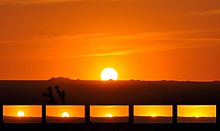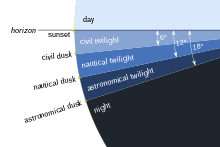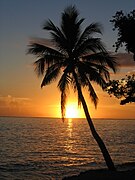what would cause a light in the sky to follow me and then disappear

The full wheel of a sunset on the Loftier Plains of the Mojave Desert.

Stages of the twilight period
Dusk, too known as sundown, is the daily disappearance of the Lord's day below the horizon due to Earth's rotation. As viewed from everywhere on Earth (except the North and Southward poles), the equinox Sun sets due w at the moment of both the Spring and Autumn equinox. As viewed from the Northern Hemisphere, the sun sets to the northwest (or non at all) in the Northern hemisphere's spring and summer, and to the southwest in the autumn and wintertime; these seasons are reversed for the Southern Hemisphere.
The time of sunset is defined in astronomy as the moment when the upper limb of the Sun disappears below the horizon.[one] Near the horizon, atmospheric refraction causes sunlight rays to exist distorted to such an extent that geometrically the solar disk is already about one bore beneath the horizon when a sunset is observed.
Sunset is distinct from twilight, which is divided into iii stages. The first ane is civil twilight, which begins in one case the Sun has disappeared below the horizon, and continues until it descends to 6 degrees below the horizon. The second phase is nautical twilight, between 6 and 12 degrees below the horizon. As for the third 1, information technology is astronomical twilight, which is the period when the Sunday is between 12 and 18 degrees below the horizon.[2] Dusk is at the very end of astronomical twilight, and is the darkest moment of twilight merely before nighttime.[iii] Finally, night occurs when the Sun reaches xviii degrees below the horizon and no longer illuminates the sky.[4]
Locations further Northward than the Arctic Circle and further South than the Antarctic Circle experience no full sunset or sunrise on at to the lowest degree ane day of the year, when the polar day or the polar night persists continuously for 24 hours.
Occurrence [edit]

The spinning Globe lit by the Sun as seen from far above the North Pole. All along the terminator, the rays from the sun hit Earth horizontally, neglecting whatsoever atmospheric effects and Globe's orbital motility.

The time of sunset varies throughout the year, and is adamant by the viewer'south position on Earth, specified past latitude and longitude, altitude, and fourth dimension zone. Small daily changes and noticeable semi-annual changes in the timing of sunsets are driven by the centric tilt of Earth, daily rotation of the Earth, the planet's motility in its annual elliptical orbit around the Sun, and the Globe and Moon's paired revolutions around each other. During Wintertime and Bound, the days go longer and sunsets occur afterwards every twenty-four hours until the day of the latest sunset, which occurs afterwards the summertime solstice. In the Northern Hemisphere, the latest sunset occurs tardily in June or in early July, but not on the Summer solstice of June 21. This date depends on the viewer'due south breadth (continued with the Earth'due south slower movement effectually the aphelion around July 4). Likewise, the earliest sunset does non occur on the winter solstice, only rather about two weeks earlier, again depending on the viewer'southward latitude. In the Northern Hemisphere, it occurs in early Dec or late November (influenced by the Earth's faster movement near its perihelion, which occurs effectually Jan three).[ citation needed ]
Too, the same miracle exists in the Southern Hemisphere, just with the respective dates reversed, with the earliest sunsets occurring some time earlier June 21 in winter, and latest sunsets occurring some time subsequently Dec 21 in summer, over again depending on 1'south southern latitude. For a few weeks surrounding both solstices, both sunrise and sunset get slightly later each day. Even on the equator, sunrise and sunset shift several minutes dorsum and forth through the year, along with solar apex. These effects are plotted past an analemma.[5] [6]
Neglecting atmospheric refraction and the Dominicus'south non-cypher size, whenever and wherever sunset occurs, information technology is always in the northwest quadrant from the March equinox to the September equinox, and in the southwest quadrant from the September equinox to the March equinox. Sunsets occur almost exactly due due west on the equinoxes for all viewers on Earth. Exact calculations of the azimuths of sunset on other dates are complex, but they can be estimated with reasonable accuracy past using the analemma.[ citation needed ]
Equally sunrise and sunset are calculated from the leading and trailing edges of the Sun, respectively, and not the eye, the duration of a daytime is slightly longer than nighttime (by about 10 minutes, as seen from temperate latitudes). Farther, because the light from the Sunday is refracted as it passes through the World'southward atmosphere, the Sunday is still visible after information technology is geometrically below the horizon. Refraction besides affects the apparent shape of the Lord's day when it is very shut to the horizon. It makes things announced higher in the heaven than they really are. Lite from the bottom border of the Sun's deejay is refracted more than than light from the summit, since refraction increases equally the angle of elevation decreases. This raises the apparent position of the bottom edge more than the top, reducing the apparent height of the solar disk. Its width is unaltered, so the disk appears wider than information technology is high. (In reality, the Dominicus is about exactly spherical.) The Sun also appears larger on the horizon, an optical illusion, similar to the moon illusion.[ citation needed ]
Locations north of the Chill Circumvolve and s of the Antarctic Circle feel no sunset or sunrise at least one day of the year, when the polar day or the polar night persist continuously for 24 hours.[ citation needed ]
Location on the Horizon [edit]

The solar azimuth angle at sunset, , as a function of latitude and day of twelvemonth for the year 2020 following the due south-clockwise convention, which means if 
Guess locations of sunset on the horizon as described to a higher place tin be found in Refs.[7] [8]
The figure on the correct is calculated using the solar geometry routine in Ref.[9] every bit follows: i.) For a given latitude and a given date, summate the declination of the Sun using longitude and solar noon time every bit inputs to the routine; ii.) Calculate the sunset hour bending using the sunset equation; three.) Summate the sunset time, which is the solar apex fourth dimension plus the sunset 60 minutes bending in caste divided by 15; iv.) Use the sunset time equally input to the solar geometry routine to get the solar azimuth angle at sunset.
Hemispheric symmetry [edit]
An interesting feature in the figure on the right is apparent hemispheric symmetry in regions where daily sunrise and sunset actually occur. This symmetry becomes clear if the hemispheric relation in sunrise equation is applied to the x- and y-components of the solar vector presented in Ref.[9]
Colors [edit]

Evening twilight in Joshua Tree, California, displaying the separation of yellow colors in the direction from the Sun below the horizon to the observer, and the blue components scattered from the surrounding sky
As a ray of white sunlight travels through the atmosphere to an observer, some of the colors are scattered out of the beam past air molecules and airborne particles, changing the last colour of the axle the viewer sees. Considering the shorter wavelength components, such as blueish and green, scatter more strongly, these colors are preferentially removed from the beam.[ten] At sunrise and sunset, when the path through the atmosphere is longer, the blue and light-green components are removed almost completely, leaving the longer wavelength orange and carmine hues we see at those times. The remaining reddened sunlight can then be scattered by deject aerosol and other relatively large particles to light up the horizon red and orange.[11] The removal of the shorter wavelengths of calorie-free is due to Rayleigh handful by air molecules and particles much smaller than the wavelength of visible light (less than 50 nm in diameter).[12] [13] The scattering past cloud droplets and other particles with diameters comparable to or larger than the sunlight'due south wavelengths (> 600 nm) is due to Mie scattering and is not strongly wavelength-dependent. Mie scattering is responsible for the light scattered by clouds, and also for the daytime halo of white low-cal around the Sun (forward scattering of white light).[14] [15] [sixteen]
A video time lapse of a sunset in Tokyo
Sunset colors are typically more brilliant than sunrise colors, considering the evening air contains more particles than morn air.[10] [xi] [xiii] [sixteen] Sometimes just before sunrise or after sunset a green flash can be seen.[17]
Ash from volcanic eruptions, trapped within the troposphere, tends to mute sunset and sunrise colors, while volcanic ejecta that is instead lofted into the stratosphere (as thin clouds of tiny sulfuric acrid droplets), tin yield beautiful mail-sunset colors called afterglows and pre-sunrise glows. A number of eruptions, including those of Mount Pinatubo in 1991 and Krakatoa in 1883, take produced sufficiently loftier stratus clouds containing sulfuric acid to yield remarkable sunset afterglows (and pre-sunrise glows) around the earth. The high distance clouds serve to reflect strongly reddened sunlight still striking the stratosphere after sunset, down to the surface.[ citation needed ]
Some of the most varied colors at sunset tin can exist found in the contrary or eastern sky after the Dominicus has set up during twilight. Depending on weather weather and the types of clouds present, these colors have a wide spectrum, and tin can produce unusual results.[ citation needed ]
Names of compass points [edit]
In some languages, points of the compass deport names etymologically derived from words for sunrise and sunset. The English words "orient" and "occident", meaning "east" and "westward", respectively, are descended from Latin words meaning "sunrise" and "sunset". The word "levant", related e.thousand. to French "(se) lever" meaning "lift" or "ascent" (and also to English "drag"), is also used to describe the east. In Polish, the word for east wschód (vskhud), is derived from the morpheme "ws" – meaning "up", and "chód" – signifying "move" (from the verb chodzić – pregnant "walk, motion"), due to the act of the Lord's day coming upward from backside the horizon. The Polish discussion for west, zachód (zakhud), is like simply with the discussion "za" at the kickoff, meaning "behind", from the act of the Dominicus going backside the horizon. In Russian, the word for w, запад (zapad), is derived from the words за – meaning "backside", and пад – signifying "autumn" (from the verb падать – padat'), due to the deed of the Sunday falling behind the horizon. In Hebrew, the give-and-take for east is 'מזרח', which derives from the give-and-take for rising, and the word for west is 'מערב', which derives from the word for setting.
Historical view [edit]
The 16th-century astronomer Nicolaus Copernicus was the first to present to the globe a detailed and eventually widely accepted mathematical model supporting the premise that the Globe is moving and the Sun actually stays still, despite the impression from our point of view of a moving Sun.[18]
Planets [edit]

Sunsets on other planets appear unlike because of differences in the distance of the planet from the Sun and non-existent or differing atmospheric compositions.[ citation needed ]
Mars [edit]
On Mars, the setting Sun appears almost 2-thirds the size as it appears from Globe,[xix] due to the greater altitude between Mars and the Sun. The colors are typically hues of blue, only some Martian sunsets terminal significantly longer and appear far redder than is typical on Earth.[20] The colors of the Martian sunset differ from those on Globe. Mars has a thin atmosphere, defective oxygen and nitrogen, then the light scattering is non dominated by a Rayleigh Scattering process. Instead, the air is full of red grit, blown into the temper by high winds,[xx] so its sky color is mainly adamant by a Mie Scattering procedure, resulting in more blueish hues than an Earth dusk. One study also reported that Martian grit high in the atmosphere can reflect sunlight upwardly to ii hours after the Sunday has set, casting a diffuse glow across the surface of Mars.[xx]
Gallery [edit]
-

Sunset in Brela, Croatia
-

See also [edit]
- Afterglow
- Analemma
- Astronomy on Mars
- Dawn
- Daytime
- Diffuse heaven radiation
- Dusk
- Earth's shadow, visible at dusk
- Gilded hour
- Sundown boondocks
- Sunrise
- Sunrise equation
- Twilight
References [edit]
- ^ Ridpath, Ian (2012-01-01), "sunset", A Dictionary of Astronomy, Oxford University Press, doi:x.1093/acref/9780199609055.001.0001, ISBN978-0-19-960905-five , retrieved 2021-10-05
- ^ "Definitions from the Us Astronomical Applications Dept (USNO)". Retrieved 2016-06-17 .
- ^ "Full definition of Dusk".
- ^ "Sunset vs Sunset [What Is The Difference Between The Two?]". Astronomy Scope. 2020-12-03. Retrieved 2021-10-03 .
- ^ Starry Night Times – Jan 2007 (explains why Sun appears to cross slow before early January)
- ^ The analemma Archived 2006-x-18 at the Wayback Machine, elliptical orbit effect. 'July tertiary to Oct 2nd the sunday continues to drift to the due west until it reaches its maximum "offset" in the west. And so from October 2 until January 21, the sunday drifts back toward the due east'
- ^ Karen Masters (October 2004). "Curious About Astronomy: How does the position of Moonrise and Moonset alter?". Curious About Astronomy? Inquire an Astronomer. Cornell Academy Astronomy Department. Retrieved 2016-08-eleven .
- ^ "Where Exercise the Lord's day and Stars Rise?". Stanford Solar Centre. Retrieved 2012-03-20 .
- ^ a b Zhang, T., Stackhouse, P.W., Macpherson, B., and Mikovitz, J.C., 2021. A solar azimuth formula that renders coexisting treatment unnecessary without compromising mathematical rigor: Mathematical setup, application and extension of a formula based on the subsolar point and atan2 function. Renewable Energy, 172, 1333-1340. DOI: https://doi.org/10.1016/j.renene.2021.03.047
- ^ a b K. Saha (2008). The Earth's Atmosphere – Its Physics and Dynamics . Springer. p. 107. ISBN978-3-540-78426-5.
- ^ a b B. Guenther, ed. (2005). Encyclopedia of Modernistic Optics. Vol. 1. Elsevier. p. 186.
- ^ "Hyperphysics, Georgia State Academy". Hyperphysics.phy-astr.gsu.edu. Retrieved 2012-04-07 .
- ^ a b Craig Bohren (ed.), Selected Papers on Scattering in the Temper, SPIE Optical Engineering science Press, Bellingham, WA, 1989
- ^ Corfidi, Stephen F. (February 2009). "The Colors of Twilight and Sunset". Norman, OK: NOAA/NWS Tempest Prediction Center.
- ^ "Atmospheric Aerosols: What Are They, and Why Are They So Important?". nasa.gov. August 1996.
- ^ a b E. Hecht (2002). Optics (4th ed.). Addison Wesley. p. 88. ISBN0-321-18878-0.
- ^ "Ruddy Sunset, Green Flash".
- ^ "The Earth Is the Center of the Universe: Tiptop x Science Mistakes". Science.discovery.com. 2012-01-23. Retrieved 2012-04-07 .
- ^ "A Moment Frozen in Time". Jet Propulsion Laboratory. June ten, 2005. Retrieved September 7, 2011.
- ^ a b c Nemiroff, R.; Bonnell, J., eds. (June 20, 2005). "Dusk Over Gusev Crater". Astronomy Movie of the Day. NASA. Retrieved September half dozen, 2011.
External links [edit]
| | Wikiquote has quotations related to: Sunset |
| | Wait upward dusk in Wiktionary, the free lexicon. |
| | Wikimedia Commons has media related to Sunset. |
| | Wikimedia Commons has media related to Sunsets. |
- Full physical explanation in elementary terms
- The colors of twilight and sunset
- Geolocation service to calculate the time of sunrise and dusk
Source: https://en.wikipedia.org/wiki/Sunset



إرسال تعليق for "what would cause a light in the sky to follow me and then disappear"